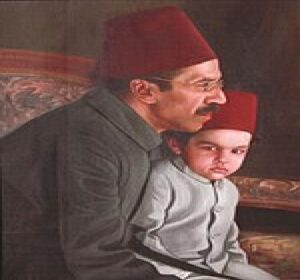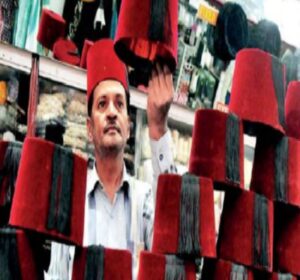In most striking colors – red and black, with a clutch of silk tassels dropping to a side, the cylindrical Rumi topi imparts a royal look to the wearer. The tall hat is also called the Nawabi topi in Hyderabad and other places.
Rumi topi, introduced to Hyderabad from Turkey, also highlighted the close relations between Ottoman Turkey and princely Hyderabad.
 Rumi topi popularised by Nizam VII, Mir Osman Ali Khan, in the erstwhile princely state of Hyderabad, is successfully fighting against the odds of changed times, modernity and fashion to survive.
Rumi topi popularised by Nizam VII, Mir Osman Ali Khan, in the erstwhile princely state of Hyderabad, is successfully fighting against the odds of changed times, modernity and fashion to survive.
While the Rumi topi (Roman cap) was banned in Turkey in 1922 after the fall of the Ottoman empire, the cylindrical red cap continued to be popular in Hyderabad and parts of undivided AP as late as 1980s. With manufacture restricted to a handful of places in the world — Hyderabad is one of them — the Rumi topi would have gone into oblivion, but thanks to people sporting it on special occasions like weddings and Eid prayers, it survives.
Rumi topi, introduced to Hyderabad from Turkey, also highlighted the close relations between Ottoman Turkey and princely Hyderabad. After the abolition of the Caliph system in Turkey, the last ruler of Ottoman empire, Sultan Abdul Mejid II, willed that if the Caliphate were to be revived, his grandson Mukarram Jah should succeed him.
Mukarram Jah is also the grandson of Mir Osman Ali Khan, and former titular Nizam VIII of Hyderabad. Mukarram Jah too had often sported the Rumi topi during his visits to Hyderabad.
Historians said while the cap is popular as Fez the world over, it is called the Rumi topi or Roman headdress in the sub-continent, as the Ottoman empire had succeeded the eastern Roman empire. Historian Allama Ejaz Farrukh said that the position of the tassel attached to the Rumi topi connotes the status of the wearer. It was once part of OU students’ uniform.
Md. Ilyas Bukhari of Mohammad Cap Mart in the bustling Madina area informs us of how the seventh Nizam of Hyderabad, Mir Osman Ali Khan, who was only 5 feel tall used to wear it to look tall, especially when meeting his foreign guests. “There is an anecdote that he would be seen in London wearing a big coat and Rumi topi, with a stick in his hand,” he states. Back then, the Christy factories in London used to make these caps.
Then there is the Fez cap, which was originally used by Turkish labourers. Now the devouts simply tie a cloth on their head during prayers.
At the sprawling 3500 square feet Mohammad Cap Mart, caps and hats of different sizes and varieties sit pretty. Its owner, the cheerful Ilyas Bukhari shares the history of this 113-year-old shop set up by his great grandfather. “My great grandfather’s pet name was Peer Md. Bukhari. He was a hefty person and would walk around wearing a vase coat. Since there were not many people in this area, they knew him well,” he recalls. The business continued with family till Md. Yakub Bukhari and his son is Md. Ilyas Bukhari. Even Ilyas Bukhari’s son manages the shop. “There have been four generations of people associated with the cap mart,” says Bukhari with pride. Incidentally the family name Bukhari is derived from Bukhara in Russia where his ancestors hailed from.
 Ilyas Bukhari is also proud of the fact that his is the only shop which deals with caps and hats. “One buys caps in small shops or on footpaths. This is one big shop dedicated to caps,” he states. Bukhari shares that while ‘topis’ are sold only by Muslims now, they were sold by people of all faiths and sects.
Ilyas Bukhari is also proud of the fact that his is the only shop which deals with caps and hats. “One buys caps in small shops or on footpaths. This is one big shop dedicated to caps,” he states. Bukhari shares that while ‘topis’ are sold only by Muslims now, they were sold by people of all faiths and sects.
He is also full of anecdotes of how rumi topis revealed the character of a person. “While a simple person adorned the topi in a certain way, a ‘powerful’ person wore it in a different way. And if it is a romantic occasion, the cap style was different. There were different cap styles and people identified one’s personality,” he says and adds, “People attended big events, parties and weddings wearing a sherwani and a classy rumi topi.”
Presently the cost of a Rumi topi ranges from ₹150 to ₹5000 in many designs and colors to suit present day fashion trends. #KhabarLive #hydnews







